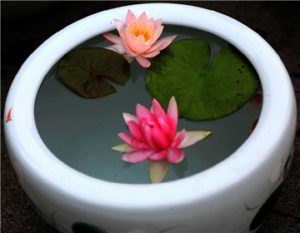A Petal Puzzle – Unryū Gama
Sen no Rikyū’s un-ryū gama, 雲龍釜, cloud-dragon kettle, is modeled on a Ming Chinese water vessel. The body of the kettle has the design of a dragon amid clouds and rain. The lid of the kettle has a design of many concentric rings that suggests water ripples. The lid has a geometric ball knob, tsumami, 摘み, pinch, with a loosely attached metal ring. The knob is set on an escutcheon, za, 座, seat, in the form of a multi-petalled flower. The flower appears to resemble a kiku, 菊, chrysanthemum and a hasu, 蓮, lotus. The question is which, or what flower is it? The escutcheon on the kama in my collection has thirteen petals. The knob is a cuboctahedron, which has fourteen facets; six squares – the number of lines of a hexagram in the Eki-kyō, 易経, Change-sutra, and eight triangles – the number of trigrams in the Ekikyō. The knob is on the center of the flower.

The case for the kiku is lengthily detailed in my article, Unryū Gama on Chanoyu Decoded. The chrysanthemum is a symbol of Japan and the crest of the emperor. The flower crest, kiku-mon, 菊紋, chrysanthemum-crest, has sixteen and thirty-two highly stylized petals radiating out from a central sun-like disk. This crest is used only by the emperor, although a kikumon with other numbers of petals has been widely used for centuries. Artistic designs of the chrysanthemum have petals with rounded ends. Three-dimensional depictions have petals that are convex. The flower is frequently depicted showing the underside, which is called ura-giku, 裏菊, under-chrysanthemum.
In Japanese symbolism, the number nine is extremely auspicious: the ultimate single digit; one in the center of eight. In the Ekikyō, the number nine is a Yō line that changes to an In line. Two nines together are auspicious, and on the 9th day in the 9th month there is a special occasion called Chō-Yō, 重陽の節句, Multiple-Yang. It is called the Kiku no se-kku, 菊の節句, Chrysanthemum’s Division-passage, which is the season of the chrysanthemum.
The Kanji for kiku, 菊, chrysanthemum, is composed of the grass crown radical, 艹, used for a plant, tsutsumu, 勹, wrap, and the Kanji for kome, 米, rice, which is symbolic of Infinity in Space. The kome Kanji is the basis of the idealized lotus flower.

The lotus flower, hasu no hana, 蓮の花, is closely associated with Buddhism, and it has petals and seedpod openings based on the number eight, hachi, 八. The number eight is symbolic of Infinity in Space. Buddhist deities are depicted sitting or standing on a lotus seedpod surrounded by petals, and may be in multiple alternate tiers. Stylized, artistic depictions of the lotus have pointed petals. Three-dimensional depictions of the lotus have concave petals, The lotus flower has a cup-like form, while the chrysanthemum flower is flat.
The Kanji for lotus, hasu, 蓮, is composed of the grass radical, 艹, for plant, and ren, 連, connect. The Kanji ren is composed of sha, 車, cart, an object with two wheels as though seen from above, and chaku, 辶, movement. In basic structure, the lotus flower resembles the Buddhist wheel of the Law, Hō-rin, 法輪, Law-ring.
The Chinese often used ceramic bowls of various sizes to keep goldfish, and grow various kinds of waterlilies and lotuses. This was adopted by the Japanese and is enjoyed around the world. Most popular plants grown in the water-filled bowls are called sui-ren, 睡蓮, drowsy-lotus, a kind of plant of the genus Nymphaea. Drowsy may refer to the flower lying on the surface of the water, rather than rise above like true lotus. The water vessel planter has soil and pots at the bottom to secure the roots, the buds rising to the surface and becoming leaves or flowers, both of which can be quite small.
The water ripples on the kettle lid, indicate action of some sort. A growing plant in the vessel would not cause ripples, unlike an object falling on the water.
Friends, if you have an unryū gama, and it has a flower escutcheon, would you please count the petals, and let me know your thoughts on its identity.
For more information on Tea and Japanese culture in March, see also: Tea in March, Tea in March Part 2, Unryū Gama, Unryū Gama Picture Gallery, and Rikyū’s Take Jizai (video).

